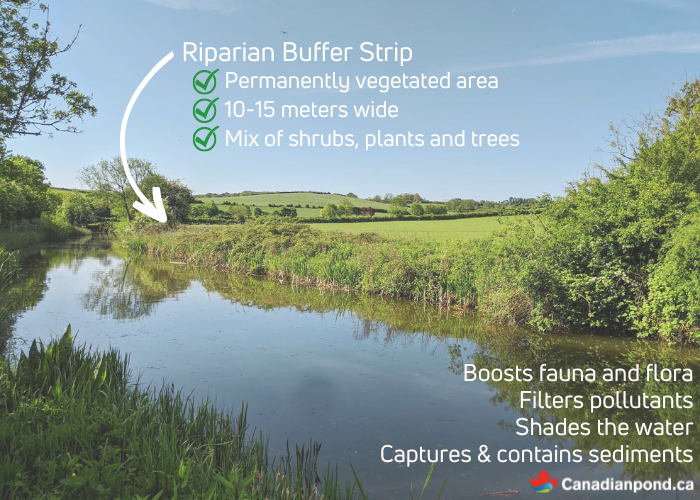Why have a riparian buffer strip?
The riparian buffer strip
What is a riparian buffer strip?
A riparian buffer strip is a permanently vegetated strip of land that should be maintained on either side of, or around, a watercourse, pond or lake. It is composed of a mixture of herbaceous plants, shrubs and trees that runs alongside watercourses, surrounds a lake or pond, or borders the river. This buffer zone between the plot of land and the watercourse may be left in its natural state or landscaped. No tillage, fertilizers, manure or pesticides may be applied in this area, but above all, the soil must not be left bare.
The purpose of a riparian buffer strip.
Protecting water quality
For ponds and lakes, riparian buffers help retain soil under the effect of water runoff, in addition to providing a protective, filtering barrier against nutrients. Riparian buffers improve water quality in numerous ways:
- They shade nearby water which keeps it cooler and avoids oxygen depletion;
- They reduce nutrient-rich runoff that arrives in the water, thereby slowing eutrophication (aging of the pond) and limiting the growth of algae and aquatic plants;
- They reduce the amount of fine sediment in the water, which increases water clarity and preserves essential habitat for many aquatic species;
- They reduce the amount of pesticide residues that make it into the water, leading to less toxic effects in the aquatic ecosystem.
Promoting biodiversity
The vegetation of a riparian buffer strip provides an environment where a wide variety of flora and fauna can flourish, contributing to biological richness. They offer shelter from weather and predators, breeding grounds and food reserves, supporting an intricate community of plants, fish, birds, mammals, amphibians and insects. The greater the variety of plants in the riparian buffer zone, the richer the ecological diversity of all species!
Shoreline stabilization
Human activities often remove natural barriers to the destructive force of running water, causing soil to be eroded away from banks and shorelines. As a result, every year, a portion of agricultural soil near ponds, lakes and other sites ends up in watercourses. Preserving and restoring riparian buffer counters this effect in two ways. Firstly, plant roots in the buffer hold the soil together, resisting erosion. Secondly, the above-ground parts of the plants soften the impact of rain and prevent the soil from drying out as much. Preserving the soil also means protecting the environment! By choosing practices that mimic those found in nature, you can protect and preserve both water quality and soil for future generations.
Filter fertilizers and pesticides from the field
Water runoff carries fine soil particles, which can in turn be loaded with fertilizer, manure and pesticide residues. The amount of these substances that finds their way into our watercourses can be greatly reduced when the runoff filters its way through a riparian buffer strip. The wider the strip, the more it can filter!
Did you know?
-
- In general, we recommend 10 to 15 meters of riparian buffer. Check with your city or municipality to find out its riparian buffer strip standards, which may differ from place to place. In Quebec, for lakes, rivers and streams, the riparian buffer zone should be 10-15 meters. For ponds, no minimum standard is set, but the riparian buffer zone is always a considerable ally near a body of water.

How do I build my buffer strip?
Several options are available to create an effective and visually pleasing riparian buffer. The herbaceous portion of a riparian buffer is composed of grasses, melliferous plants (whose flowers produce nectar) and other low-growing plants. The smaller roots of these species are less stable than the other types of vegetation but are excellent for sediment filtration. The shrubby portion of the riparian buffer, often composed of a mixture of shrubs and herbaceous plants, offers robust bank stabilization due to the shrubs’ extremely strong root system.
The arboreal component of the riparian buffer, composed of trees, shrubs and herbaceous plants, has a the most extensive root system, and provides beneficial shade that favors aquatic fauna. It is excellent for bank stabilization, calming winds, water cooling and providing aquatic and terrestrial wildlife habitat. It also acts as a windbreak. We recommend creating a riparian buffer strip with as many trees and shrubs as possible for their stabilizing properties and to provide shade for the water, which is especially beneficial during hot spells. Moreover, muskrats are 3 times less present in an environment where there are shrubs and trees. Their roots are an obstacle to burrowing, which can lead to dislodging and damage to your pond.
Keep an eye on these 5 invasive plants that have no place in a riparian buffer zone:
– Reed canary grass (Phalaris arundinacea)
– Giant hogweed (Heracleum mantegazzianum) (problem in the making)
– Japanese knotweed (Reynoutria japonica)
– Common reed (Phragmites australis)
– Purple loosestrife (Lythrum salicaria)
– And more here
Save yourself a lot of trouble down the road – don’t forget to ask about the plants you choose for your landscaping!
Using native species means greater planting success and minimal maintenance. In addition, these naturally occurring species are adapted to our local ecosystems so there’s no need to add fertilizer or compost.
Lastly, before planning any work around a body of water, it’s essential to obtain the necessary information and permits from the relevant authorities. Plan ahead! You wouldn’t want delays in processing your permit application to cause you to miss an important planting window.
In short your riparian buffer strips are crucial for preserving your water quality and for establishing a healthy, low-maintenance ecosystem. For more information, you may also like;
A little more information on aquatic plants!
New pond owner, where to begin!
Fish habitat: Does aeration warm the pond?